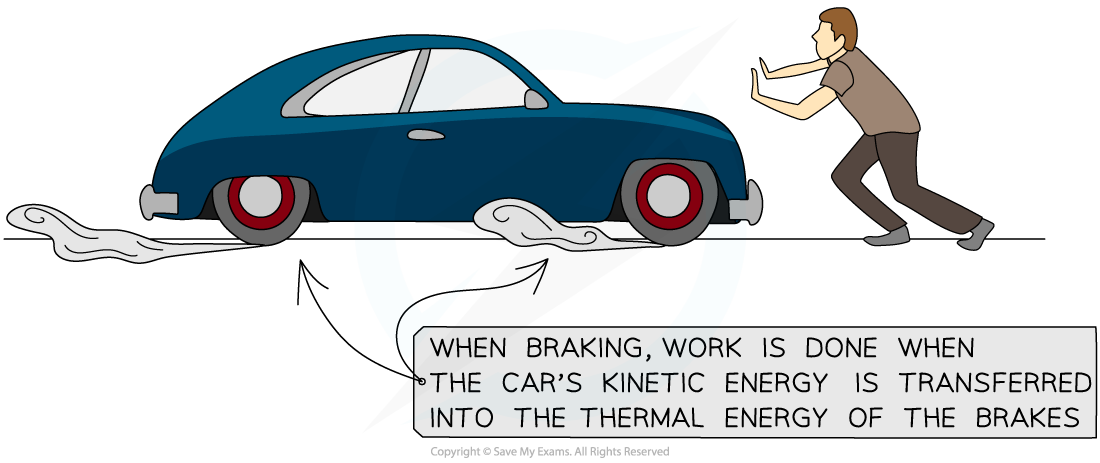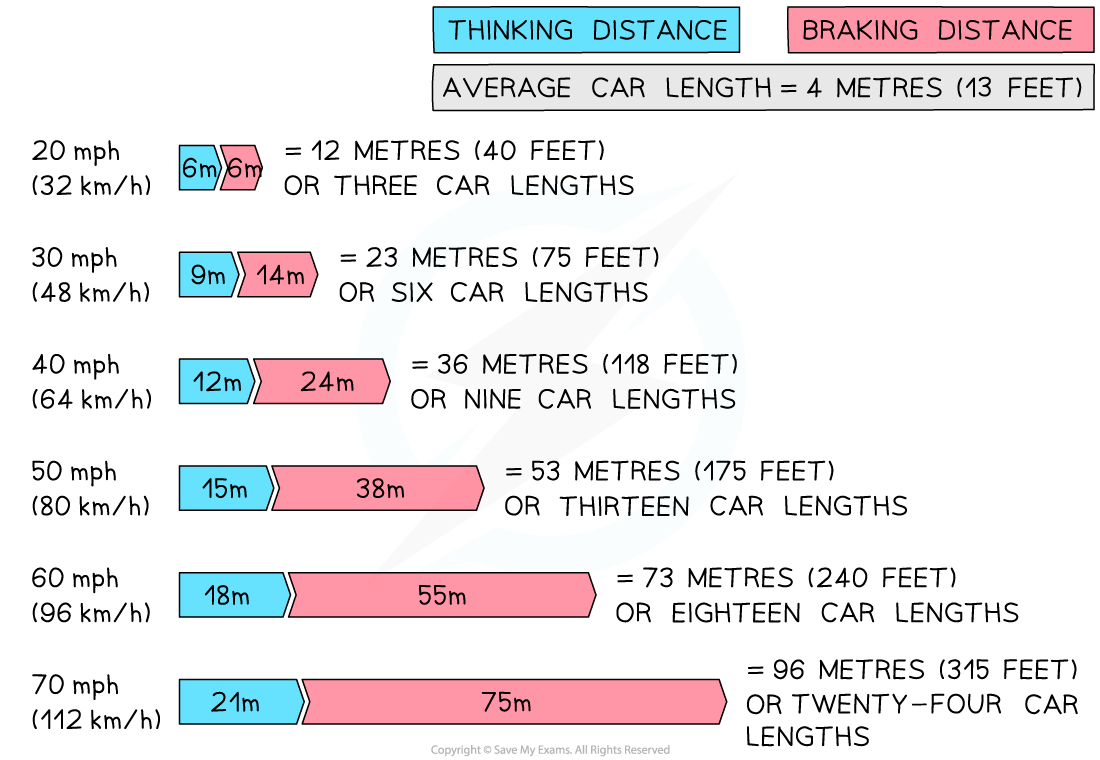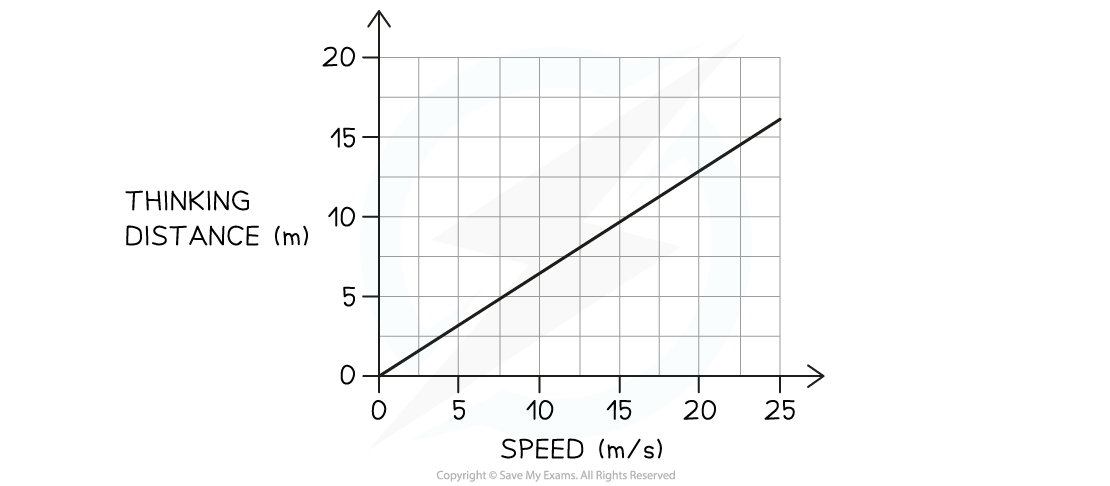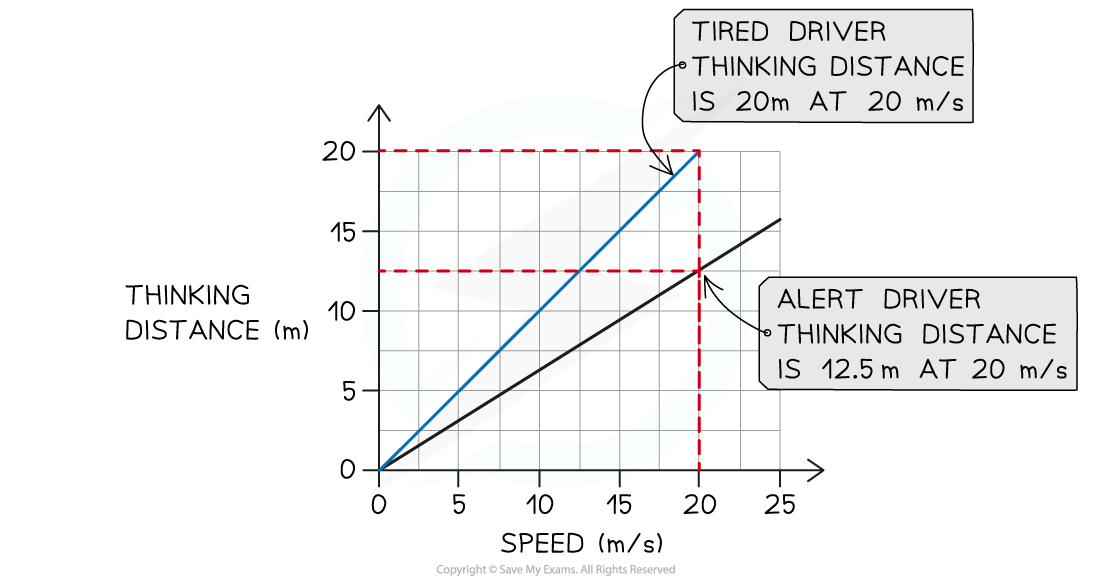Thinking, Braking & Stopping Distances (WJEC GCSE Science (Double Award)): Revision Note
Thinking, Braking & Stopping Distances
Principles of Forces and Motion
When a driver applies the brakes, there is a frictional force between the brakes and the wheels of the car, also known as the braking force
This frictional force does work on the brakes - i.e. it transfers energy from the car to the brakes
Therefore, the kinetic energy of the car decreases and the thermal energy of the brakes increases - i.e. the brakes heat up
This means the car decelerates (slows down)
Work Done when the Braking Force is Applied

Work done by breaking transfers energy from the kinetic store into the thermal energy store
The greater the speed of a vehicle, the greater the braking force required to bring the vehicle to a halt for a given distance
This is due to the link between resultant force and acceleration as stated in Newton's second law of motion
Since the braking force would need to be larger, the deceleration of the vehicle will be large as well
Large decelerations could lead to the brakes overheating and / or loss of control of the vehicle
Stopping Distance
The stopping distance of a car is defined as:
The total distance travelled during the time it takes for a car to stop in response to some emergency
It can be written as an equation involving two distances:
Stopping distance = Thinking distance + Braking distance
Thinking Distance
Thinking distance is defined as
The distance travelled in the time it takes the driver to react (reaction time) in metres (m)
The main factors affecting thinking distance are:
The speed of the car
The reaction time of the driver
The reaction time is defined as:
A measure of how much time passes between seeing something and reacting to it
The average reaction time of a human is 0.25 s
Reaction time is increased by:
Tiredness
Distractions (e.g. using a mobile phone)
Intoxication (i.e. consumption of alcohol or drugs)
Breaking Distance
Braking distance is defined as
the distance travelled under the braking force in metres (m)
For a given braking force, the greater the speed of the vehicle, the greater the stopping distance
Calculating Stopping Distance
For a given braking force, the speed of a vehicle determines the size of the stopping distance
The greater the speed of the vehicle, the larger the stopping distance
The Effect of Speed on Stopping Distance

A vehicle's stopping distance increases with speed. At a speed of 20 mph the stopping distance is 12 m, whereas at 60 mph the stopping distance is 73 m (reproduced from the UK Highway Code)
A Table Showing Speed and Stopping Distance
Speed (mph) | Speed (m/s) | Stopping Distances (m) |
|---|---|---|
20 | 9 | 12 |
30 | 14 | 23 |
40 | 18 | 36 |
50 | 22 | 53 |
60 | 27 | 73 |
Worked Example
At a speed of 20 m/s, a particular vehicle had a stopping distance of 40 metres. The car travelled 14 metres whilst the driver was reacting to the incident in front of him.
What was the braking distance?
A. 54 m
B. 34 m
C. 26 m
D. 6 m
Answer: C
Step 1: Identify the different variables
Stopping distance = 40 m
Thinking distance = 14 m
Step 2: Rearrange the formula for stopping distance
Stopping distance = Thinking distance + Braking distance
Braking distance = Stopping distance – Thinking distance
Step 3: Calculate and identify the correct braking distance
Braking distance = 40 – 14
Breaking distance = 26 metres
Therefore, the answer is C
Worked Example
The graph below shows how the thinking distance of a driver depends on the speed of the car.

(a) Use the graph to describe the relationship between thinking distance and speed.
(b) Some people drive when they are tired, despite warnings against doing so.
Draw a new line on the graph to show how thinking distance varies with speed for a tired driver.
Answer:
Part (a)
Step 1: Check if the line is straight and if it goes through the origin
The graph shows a straight line through the origin
Therefore, the thinking distance is directly proportional to the speed of the car
Part (b)
Step 1: Recall the factors which affect the thinking distance
Three additional factors affect the thinking distance, because they affect human reaction time:
Tiredness
Distractions
Intoxication
Hence, a tired driver's reaction time is greater (i.e. it takes longer for them to react)
Step 2: Draw a line that shows greater thinking distance for the same speed
At the same speed, a tired driver's thinking distance will be greater than a driver who is alert
This means a line should be drawn with a steeper gradient, as shown below:

Worked Example
Higher Tier Only
A car is travelling at 15 m/s when the driver applies the brakes. The car decelerates uniformly and stops. The mass of the car and the driver is 1500 kg, and together they have a total kinetic energy of 168 750 J.
(a) Determine the work done by the braking force to stop the car and the driver.
(b) The braking force used to stop the car and the driver was 6000 N.
Calculate the braking distance of the car.
Answer:
Part (a)
Step 1: Recall the process of applying brakes to a vehicle
The work done is the energy transferred from the car and driver to the brakes
This energy transfer is from kinetic energy to thermal energy
In this case, the car is brought to a complete stop, so 168 750 J of energy is transferred from kinetic energy to heating up the brakes (assuming all energy is transferred to heat only!)
Part (b)
Step 1: State the equation for work done
Work done = Force × distance travelled
In this case, the force doing the work (transferring energy) is the braking force
Step 2: Rearrange the equation and solve for distance travelled
Step 3: Substitute the values for work and force
Hence the braking distance (the distance travelled by the car under the braking force) is 28.1 m
Examiner Tips and Tricks
If you are asked to explain why the temperature of the brakes increases when a vehicle stops, remember, work is done by the frictional force between the brakes and the wheel. It's a common mistake to write about the friction between the wheels and the road. This does happen, but in this case, the wheels heat up the road! The brake temperature increases because there is a transfer of energy from the car's kinetic energy to the thermal energy of the brakes.

You've read 0 of your 5 free revision notes this week
Sign up now. It’s free!
Did this page help you?
